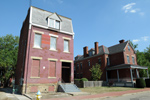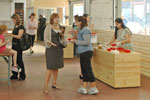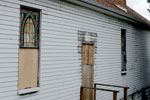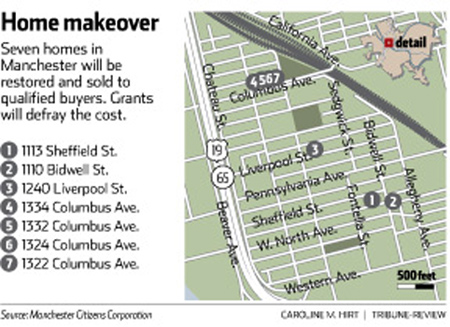
Category Archive: Pittsburgh Tribune Review
-
Work on Former Hollow Tavern Progressing
By Jewels Phraner
LIGONIER ECHO
Thursday, September 2, 2010
Fred Haeflein works on reviving the Hollow Tavern on Route 30 outside of Ligonier. Jared Wickerham | Tribune-Review
Saving Sleepy Hollow hasn’t gone exactly the way owner Fred Haeflein expected.
He’s had a skilled crew at work rebuilding the log landmark, but now he’s looking for a good chef and manager to operate the restaurant.
After an arson destroyed the building in February 2008, causing so much damage that Unity code enforcement officer Merle Musick condemned the property, Haeflein bought it with the intention of restoring it.
Financial troubles plagued the project early on, and this summer Haeflein said he has struggled to find the right person to run the restaurant. Although he has fond childhood memories of the restaurant, he has no interest in running the facility once it’s finished.
“I don’t cook. I’m not a restaurant manager,” Haeflein said. “I build things. I save things. I just want this building here.
“I need a good restaurateur – no, I need a great restaurateur – to keep this place running for a long time,” he said.
When the project ran into financial problems in early 2007, The Progress Fund, a Greensburg-based nonprofit lending organization approached Haeflein about a loan.
“That valley is so great. So many people enjoy driving through it. And we thought it would be a nice venue for people to stop and enjoy the valley,” said David Kahley, chief executive officer for the organization, which focuses on tourism-oriented projects.
Project loan officer Bob Patter said that while people might not see progress as they drive by the building, that doesn’t mean work isn’t being done behind the scenes.
“It’s still a very active project,” he said. “Fred is moving forward with it. Perhaps not at the pace everyone would like to see, but he’s trying to find the right person to run the restaurant for him.”
Haeflein said he expected to buy exterior logs for the building. But he wasn’t able to find the correct size and had to custom-make them instead.
“I wanted them to be as close to the original (Sleepy Hollow) as possible, and you just can’t buy logs that width anymore,” he said.
So Haeflein spent part of the summer using an ancient mill in his New York shop to cut logs, then transporting them to Ligonier.
“This is probably a lot like how the original logs were made,” he said. “It’s a pure miracle that (the mill) actually worked. That mill is probably as old as this building and hasn’t been used in 20 years.”
For now, only a few logs are secured to the building, but Haeflein said he will be back to finish the job soon.
Kelly’s Sleepy Hollow LLC was formed by Haeflein and his brother, Rich, who have been restoring the landmark west of Ligonier for about two years.
Edgar Wiltrout of Ligonier is serving a 10- to 28-year prison sentence for torching the restaurant and tavern on Feb. 23, 2008, because the former owner owed Wiltrout $1,000 and fired his girlfriend as a cook.
-
7 Homebuyers Sold on Manchester Vision
By Adam Brandolph
PITTSBURGH TRIBUNE-REVIEW
Thursday, September 2, 2010
Linda Nelson, chairwoman of the Manchester Citizens Corporation, inspects one of the properties being restored on Columbus Avenue in Manchester. The home was purchased as part of the Great House Sale. Jasmine Goldband | Tribune-Review
For the first time in years, Anthony Clark sees a reason to invest in his North Side neighborhood.
“Manchester is really starting to get going, and after 15 years of renting, I think it’s a good time,” said Clark, 44. “I think we’re about to see some really great things.”
For years, the city demolished vacant homes in Manchester, turning usable buildings into weed-filled lots that became overrun with graffiti and trash. The vacant lots made selling homes difficult, and people living there say the community suffered despite the fact that police records show the number of crimes fell by nearly half over the past decade.
“When you have a tooth out, the disease begins to spread,” said Linda Nelson, chairwoman of the Manchester Citizens Corporation, a community group founded in 1965 that helped spur more than $40 million in developments and initiatives. “If (buildings) come out, it’s definitely a hindrance. If we can renovate them, it’s a plus.”

An abandoned structure (left) on the 1100 block of Bidwell Street in Manchester is one of several slated for rehabilitation. Jasmine Goldband | Tribune-Review
With the group’s managing director Stanley Lowe urging the city to save buildings from demolition, the wrecking ball slowed. Along with the Pittsburgh History & Landmarks Foundation, it identified 110 buildings that should be saved, 63 of which are considered a priority.
Lowe said he reminded members of the city’s Historic Review Commission about the neighborhood’s rich architectural and cultural heritage, which helped Manchester achieve city and national historic status in 1979.
“Once you tear down the building, you can never go back,” Lowe said.
In October, the citizens’ group showcased seven homes to be restored by March. More than 100 people, some from as far away as Venezuela and Colombia, attended a two-day session that included a seminar educating them about how to buy one of the homes.
Twenty-five people put down $1,500 deposits, and seven qualified buyers were chosen at random to buy the homes. The rest were put on a waiting list for future restorations.
“The homes were a terrible mess,” Nelson said. “But the people who came in saw our vision.”
The cost to restore each home will range from $150,000 and $450,000, but they will sell for $90,000 to $200,000.
Incentives totaling $2 million for the buyers will be paid by grants from the city’s Urban Redevelopment Authority, the federal Department of Housing and Urban Development, Allegheny County, the Pittsburgh History & Landmarks Foundation’s Landmarks Community Capital Corporation and the Allegheny Foundation.
City Councilman R. Daniel Lavelle, whose district includes Manchester, said the strategy “fits the city’s economic reality.”
“The city can’t afford to do it all at once, so (the citizens’ group has) identified key properties they want to save,” Lavelle said. “I think it’s a tremendous project.”
Preserving the “architectural fabric” of the historic district has been ongoing since the 1970s, said Arthur Ziegler, president of the landmarks foundation.
Rob Stephany, executive director of the redevelopment authority, said the restorations are a “really bright strategy,” especially because they’re near construction at Columbus Square, a $15 million, 31-home development on four acres.
“Manchester has everything working for it,” he said.
-
Public Market in Strip to Open Sept. 10, Feature Specialty Items
By Michael Machosky, PITTSBURGH TRIBUNE-REVIEW
Tuesday, August 31, 2010
Siblings (from left), Xanthe Schandelmeier, 5; Coco, 9; and Vivienne, 7, of Squirrel Hill, sample sweets at Prasad Potluri's Spice by Tamarind booth in the Pittsburgh Public Market. More than 40 vendors will showcase their wares in a 10,000-square-foot area of the Produce Terminal Building. The grand opening will be Sept.10. The market will be open Fridays, Saturdays and Sundays. Heidi Murrin | Tribune-Review
From homemade pierogies and duck pate with pistachios and fresh herbs to old-school Italian ice and locally-brewed beer — the Pittsburgh Public Market is so close, you can almost taste it.
“It will be 45 years in November since Pittsburgh had a public market,” said Becky Rodgers, executive director of Neighbors in the Strip, who vividly remembers the last one — the long-demolished North Side Market House. “My great uncle Bob was a butcher there. My whole family used to go — it was like a sight-sound-smell extravaganza.”
Starting with a soft opening Friday, the long-delayed Pittsburgh Public Market finally will open to the public. On Sept. 10, there will be a clamorous Grand Opening marked by the ringing of bells — the public is invited to bring their own to add the racket.
Unlike Pittsburgh’s seasonal farmers markets, this indoor market will be open every weekend year-round. The $1.3-milllion project will have more than 40 vendors in 10,000 square feet of space — which is only a small slice of the blocks-long Produce Terminal Building along Smallman Street, where it is housed. The entrance is near 17th Street.
It’s been a delicate balancing act from the start, which began in 2001. Spaces from 6,500 square feet to 30,000 square feet were considered. And finding a way to avoid diverting business from the Strip’s established food purveyors was a major concern.
“You’ll notice we don’t have a fish place in our market — that’s a very usual kind of thing to have in a market,” said Cindy Cassell, the market manager for Neighbors in the Strip. “We don’t have a cheese place. We’re really working hard not to replicate existing niche markets.”
Vendors quite literally are all over the map — from Gosia’s Pierogies to Sito’s Mediteranean dressings, to Ekh’s authentic Indian vegetarian dishes, to Mushrooms for Life, foraged from around Western Pennsylvania.
Kevin Costa was slicing up duck pate and “Gin & Juice Salami” Tuesday morning at the Crested Duck Charcuterie, a specialty meat market with a booth near the entrance.
“We wanted to start our own business, but it would have been impossible to duplicate the foot traffic of the Strip, so this is perfect,” Costa said.

On Sept. 10, the PIttsburgh Public Market will open for business inside the Produce Terminal Building in the Strip District. More than 40 vendors will showcase their wares with everything from baked goods to artwork, barbecues to microbrews. Heidi Murrin | Tribune-Review
Starting a business is a lot less daunting for vendors when they’re paying $25 a day for a 10-foot-by-6-foot booth or $50 a day for a 10-foot-square booth.
“One of our challenges has been to get the concept across that, while this is not necessarily full-time, it’s also not a farmer’s market where you just show up and put your tablecloth down,” Cassell said. “It’s a little more permanent than that. So there is some planning involved for your booth. The booths are small, but from a financial perspective, I think it’s very accessible for a new business.
“We do have a lot of startups that are coming in,” she said. “That’s one of our goals, to incubate new businesses. And you know everything will be realized when they grow up and need a storefront, and can, hopefully, take an empty storefront in the neighborhood.”
Other vendors just want a little more visibility.
The Spice by Tamarind booth stocks Indian spices, snacks, chutneys, ready-to-eat meals and specialties like eggless cakes. Owner Prasad Potluri runs several Indian restaurants and small grocers in the region.
“It’s to make people aware of the restaurants and food,” Potluri said of the reason behind his participation.
For some, it’s simply a way to make it easier for customers to find their product.
Scott Smith, of East End Brewery, always assumed most of the sales for his Big Hop IPA and Black Strap Stout would be wholesale to bars and restaurants. But craft-beer fans just kept searching out the tiny, out-of-the-way brewery.
“We’re in an unmarked building in Homewood, and half our business is walk-in traffic,” Smith said.
Now, customers can sample Fat Gary Nut Brown Ale and Pedal Pale Ale at the Pittsburgh Public Market, and fill up their growlers to take home.
Not everything in the market is edible.
Babouche sells Moroccan crafts, jewelry, scarves and leather goods. Iron Eden is renowned for beautiful ironwork — flowers, trellises, sculpture — often made from recycled scrap metal. Jenn’s Jems features knit and crocheted items, and handmade jewelry.
Markets in other cities — like Cleveland’s West Side Market and Seattle’s Pike Place Market — have become first-day tourist attractions.
The Pittsburgh Public Market is starting on a much smaller scale, of course, but drawing new shoppers to the Strip is part of the plan.
“When we had Campos do a consumer market survey for us in 2006, at that time, we were planning for about 30,000 square feet,” Cassell said. “According to the consumer survey, it would add about 12,000 additional shoppers to the Strip every week. Now we’re scaled back in 10,000 square feet. But one of our goals is to increase the customer base for the entire Strip.”
Pittsburgh Public MarketWhen: Opens Friday, with Grand Opening Festivities Sept. 10-12
Hours: 9 a.m.-7 p.m. Fridays, 9 a.m.-5 p.m. Saturdays, 10 a.m.-4 p.m. Sundays
Where: 17th and Smallman streets, Strip District
Details: 412-281-4505 or website
-
Historical Groups Left in Lurch by Funding Cuts
By Richard Robbins, Pittsburgh TRIBUNE-REVIEW
Sunday, July 25, 2010
Museum inn keeper and Curator Jim Koontz, of Ligonier, builds a birdhouse that is being modeled after the Laughlintown museum's cook house. Barry Reeger/Tribune-Review
Just two years ago, Soldiers & Sailors Memorial Hall & Museum, the Oakland landmark honoring veterans of all of America’s wars, was on the receiving end of a nice piece of change from Pennsylvania: $260,000.
In 2009, the state’s largesse shrank dramatically, to a mere $30,000.
This year, Soldiers & Sailors is in line to get nothing, a result of a state budget that eliminated grants for historical sites, from the 218-acre Bushy Run Battlefield in Penn Township to the smallest local historical society.
The funding cuts will have a huge impact on groups devoted to local history, according to Ronald Gancas, Soldiers & Sailors president and CEO.
He foresees severe retrenchments, including the continuation of a wage freeze in effect at Soldiers & Sailors since 2007 and the need to recruit and mobilize even more volunteers. The museum’s education department has gone from five full-time and two part-time employees a few years ago to one full-time and one part-time employee today.
“If this trend continues, it will take 50 years to put things back together,” Gancas said.
The 2009 state budget contained $1.7 million for regional and local history, a sum that the state House added after several months in which it appeared there would be no funding for historical groups.
But this time around, there was no late change to rescue local history grants, either for general operations or special projects.
There was lip-service support for public history from members of the General Assembly but nothing more, said Deborah Filipi, executive director of the Pennsylvania Federation of Museums and Historical Organizations.
“We are in a crisis, there is no doubt about it,” Filipi said. “There are some museums that are already hurting. I suspect some of these are not going to survive.”
Jeremy Burnworth, president of the Fayette County Historical Society, said the funding cuts could not come at a worse time for his group, which conducted a ribbon-cutting ceremony Friday at its new museum and headquarters in a renovated 1700s building.
“This is really bad timing,” Burnworth said, adding that the historical society will be “held back without” the state dollars. He was counting on $10,000 from the state and a $10,000 match from the county to help staff the museum and the Searight Tollhouse, both along the National Road.
“We were on track” for the funding, Burnworth said. Now the game plan is to utilize volunteers in place of paid staff.
Tina Yandrick, director of operations for the Ligonier Valley Historical Society, said the expiration of funding meant elimination of summer internships cutting general maintenance “over and above the usual.”
Yandrick noted Compass Inn, a restored Laughlintown stagecoach stop built in 1799, “always” needs refurbishing.
Nevertheless, she said, “we are fortunate we have Compass Inn,” a money-maker for the society that helps to offset the loss of state money.
State funding was “always important money for us,” said Lisa C. Hays, executive director of the Westmoreland County Historical Society, adding that money has been so scarce, “I’m trying to get through this month.”
“We’ve already tightened our belts a lot,” Hays said. She forecast the potential for shorter business hours beginning in 2011 to “save staff time.” However, because the society likely will make a greater effort to raise private dollars, Hays was uncertain if savings are actually possible.
-
Vandergrift Moves to Preserve Look of Borough Property
By Rossilynne Skena
VALLEY NEWS DISPATCH
Monday, July 26, 2010Borough residents who cut down trees between the sidewalk and the curb could face a fine.
Those trees are borough property, officials say.
A new ordinance would enforce that by prohibiting residents from trimming or removing trees along the street — even those in front of their house.
Councilwoman Kathy Chvala leads the borough’s tree committee, which includes two other council members and four residents.
Chvala said the fine for a resident cutting down a tree along the street has not been determined.
She said the property owner would be billed for the cost of replacing the tree.
She expects council to consider the matter in September.
Chvala said she’s heard mostly positive feedback.
The only negative feedback she’s heard is from people who want to have a tree cut down when it’s healthy.
“We really want to maintain what we have,” she said.
But council president Brian Carricato said “trees are a very touchy issue in town.”
It’s not just residents who want to cut down healthy trees that they don’t want. He said but others insist on keeping dying trees standing.
Mayor Lou Purificato said property owners cutting trees down on their own doesn’t happen often.
Carricato said the committee wants to keep the town looking the way it does.
“The last thing you want to do is drive down a street with trees and now they’re all cut down,” he said.
Chvala remembers beautiful fall foliage along Vandergrift’s curved streets.
“There was a time that there was twice as many trees in town,” she said. “Probably more than that.”
Chvala likes to see healthy trees bloom again in the town with colorful autumn leaves.
Removing dead trees
While trying to save healthy trees, the borough has awarded a contract with a tree service to clear out the dead ones.
By fall, the tree committee will start placing those trees with healthy ones.
M&M Tree Service of Apollo has been awarded a contract worth between $4,500 to $5,000 for tree removal or trimming, Chvala said.
Nine types of dead trees will be removed along Hancock Avenue, West Adams Avenue, East Adams Avenue, Sherman Avenue, and Lafayette Street.
Eleven trees along Hancock Avenue, Sherman Avenue, Jefferson Avenue, Harrison Avenue, Franklin Avenue and Lafayette Street will be trimmed.
The tree committee is looking for donations, Chvala said. Anyone who is interested in donating should contact the borough secretary at 724-567-7818.
Contributing writer Dale Mann contributed to this report.
-
Foundation Offering Money to Help Churches Pay For Repairs
By Jodi Weigand
PITTSBURGH TRIBUNE-REVIEW
Monday, July 26, 2010
Stained-glass windows at First Baptist Church of Glassport were vandalized Thursday. The church hopes to obtain help from the Pittsburgh History & Landmarks Foundation's Historic Religious Properties Program to make repairs. Jasmine Goldband | Pittsburgh Tribune-Review
A small Glassport church might have to pay thousands of dollars to replace antique stained-glass windows broken by vandals.
“They were all handmade,” said the Rev. Ira Kelly, co-pastor of First Baptist Church of Glassport. “They’re as old as the church is, and now they’re lying here on the floor in pieces.”
In addition to the heartbreak of losing the four 100-year-old windows in the sanctuary late last week, the congregation is suffering sticker shock. Replacements could cost as much as $12,000, Kelly said. That’s a tall sum for the 25-member church, he said.
In a twist of fate, the vandals hit shortly after the Pittsburgh History & Landmarks Foundation announced the revitalization of a program that could help the congregation pay for the damage. After two years of struggling to fund its Historic Religious Properties Program, the foundation said, an influx of donations has helped raise more than $100,000 for grants to assist churches in paying for renovations.
“We all felt it was an overwhelming response from our contributors,” said Carole Malakoff, coordinator for the foundation’s religious properties fund. “We were really thrilled at how this (fund drive) turned out.”
Due to a lack of money, the foundation had not awarded any religious property grants this year and gave just $32,000 in 2009, she said. Typically, the fund yielded about $75,000 a year in grants.
The recent fundraising push began three months after the foundation’s annual appeal netted just $22,000. Two members offered a $25,000 challenge grant, to which the foundation added a challenge grant of $12,500. The campaign ended last week with 288 gifts totaling $62,710.
Churches in Allegheny County that are more than 50 years old can apply for a grant of up to $10,000 to be disbursed in 2011. It’s a matching grant, meaning that if a church gets $5,000, the congregation must raise $5,000 to match it.
Malakoff said she has fielded calls from numerous church leaders seeking money to repair gutters and roofs damaged in February’s record snowfall. The foundation gets about 35 formal applications a year from churches seeking grants.
This year, the foundation has limited the scope of work to exterior renovations, including stained-glass windows, roofs, gutters and masonry work, Malakoff said.
“Those are big issues with historic properties,” she said.
Since 1997, the foundation has awarded about $700,000 in grants, which resulted in about $2.4 million in work on 100 historic religious buildings. Many churches raise money above and beyond the required matching funds, Malakoff said.
The foundation wants to keep the tradition going by establishing an endowment for permanent funding of the religious properties program, she said.
“We look at them as the major cornerstone of a community,” Malakoff said. “Many of these buildings are used for all kinds of community outreach programs. They’re of utmost importance to the community.”
On the WebApplications for grants through the Pittsburgh History & Landmarks Foundation’s Historic Religious Properties Program are available online at phlf.org.
For details about a September technical assistance workshop for churches planning renovations, e-mail Carole Malakoff at hrp@phlf.org.
-
170-Year-Old Tavern in Menallen to Serve Up the Past
By Mary Pickels
TRIBUNE-REVIEW
Thursday, July 22, 2010
Fayette County Historical Society President Jeremy Burnworth is in the restored main room on the second floor of the former Abel Colley Tavern, which will is the society's headquarters. Barry Reeger | Tribune-Review
The Fayette County Historical Society Friday will hold a grand opening of its museum, to be housed in the former Abel Colley Tavern in Menallen.
Open to the public, the 3 p.m. program will showcase the restored red-brick structure at 7083 National Pike.
Last July, Warren and Virginia Dick of Smithfield donated the 170-year-old building to the historical society. Volunteers helped to restore the property, which is listed on the National Register of Historic Places.
Society President Jeremy Burnworth credited volunteer Tom Buckelew and former intern Bill Zinn, along with inmates from the State Correctional Institution at Greene, who performed labor through the Community Works Program, for much of the renovation.
Community volunteers pitched in to paint walls, install moulding and restore hardwood floors.
Although some work remains, the majority of the main rooms have been restored, Burnworth said.
Photos to be displayed Friday will show the “before” and “after,” he said. “You will be able to see (the volunteers’) accomplishments in a short amount of time. We want to let people see the beautiful work that has been done.”
Additional work will help take the structure to its next level, becoming a museum, Burnworth said.
“It’s Fayette County’s first-ever historical museum,” he said. “It’s kind of a big deal.”
Friday’s program will include local government officials, Dick family members and representatives from the National Road Heritage Corridor and the Sen. John Heinz History Center. The historical society is an affiliate of the history center and may benefit in the future through a display of Civil War memorabilia, Burnworth said.
In the future, the site will be used for the society’s headquarters. It will be available for fundraisers and meetings.
Donations of historical artifacts pertaining to Fayette County are welcome.
“They can go way back, 50 to 250 years old,” Burnworth said. “For example, think of veterans.”
There has been no place in the county to display photos, uniforms, letters or furniture, he noted.
“We are afraid people will be throwing things away,” he said. “We really want a situation in place, so even if family members are not interested, we can protect and archive (those items). We get lots of calls for information, requests to come to the building and look at the archives and all of the things people think we have.”
Plans include a gift shop, likely to include publications and books on the region’s history. In acknowledgement of the building’s history, keepsake mugs will be sold on Friday.
Public visitation hours have not been set.
“The committee will help determine the direction of ‘what’s next,'” Burnworth said.
For more information, or to donate or volunteer, visit the society’s website at www.fayettehistory.org. Anyone interested in attending Friday’s opening or joining an advisory committee is asked to call 724-439-4422.
-
Movie Money Spurs Vandergrift Spending Ideas
By Rossilynne Skena and Dale Mann, VALLEY NEWS DISPATCH
Monday, July 19, 2010The borough received $15,000 for opening its streets in June to crews filming “I am Number IV,” an action-packed thriller.
Of the money received from DreamWorks, $5,400 has be allocated to parking meters. There are about 250 parking meters on the borough streets, and those meters need constant updates, council president Brian Carricato said.
The average parking meter costs about $110. Fifty new meters will be purchased and will go into circulation where meters are broken or missing.
Council will vote at its August meeting about how to spend the remaining $9,600.
Carricato would like to see the full sum of the money remaining go toward the recreation committee.
DreamWorks wants to see the money applied to something such as recreation, something the town can look back on in 10 years as an accomplishment, Carricato said.
Typically, he said, recreation is an area where budgets can be cut because other things are more essential.
“There’s not too many times that you do have the opportunity to invest back into your recreation department,” Carricato said.
Christine Wilson, a council member who serves as chairwoman of the budget committee, proposed another plan.
She too would like to see the $5,400 go toward meters, and then allocate $6,500 to codify the borough’s ordinances, which haven’t been updated since 1998. The remaining $3,100 would go to recreation.
Carricato said there’s money in the general fund to use for codifying ordinances.
“We have $42,000 from gas wells in the general fund that should be used for codifying the ordinances,” Carricato said, adding that two more gas wells, located near the Vandergrift Cemetery, will be starting up in the next few weeks.
Wilson said that $20,000 is put into the bank up front for each gas well, and that money is supposed to be used for emergencies.
“I don’t like dipping into that money that we’re putting into the bank for emergency-use only,” Wilson said.
The three operational gas wells brought in more than $25,519.30 for the borough between January and June 30, Borough Secretary Steve DelleDonne said. Wells are located behind the municipal garage, on the Ninth Street Alley above East Vandergrift and on hillside dropping into East Vandergrift, Carricato said.
Wilson disagreed with using any of the gas well funds. Carricato said the money from the gas wells is budgeted into the general fund as anticipated revenue.
Discussion of what to do next was tabled until the next meeting, Wilson said, at which point the recreation committee will bring proposals of how to use the funding.
Carricato and two others recreation committee will meet to discuss ideas, but as for what ideas they have, residents will be in suspense until council meets.
“We’ve already been brainstorming,” Carricato said.

